Venus Atmospheric Dynamics at Two Altitudes: Akatsuki and Venus Express Cloud Tracking, Ground-Based Doppler Observations and Comparison with Modelling †
Abstract
1. Introduction
2. Wind Determination Methods at the Cloud Top
2.1. Cloud-Tracking Method—Wind Retrieval with Akatsuki UVI and VEx/VIRTIS-M
2.2. Doppler Wind Retrieval with CFHT/ESPaDOnS
2.3. Modelling
3. Observations
3.1. Akatsuki/UVI and VEx/VIRTIS-M Description of Observations
3.1.1. Geometry of Observations with Akatsuki/UVI
3.1.2. Geometry of Observations with VEx/VIRTIS-M
3.2. CFHT/ESPaDOnS Observations
4. Cloud-Tracking Results
4.1. Akatsuki UVI 283 nm Filter Wind Velocities’ Results
A Comparison of Akatsuki Zonal and Meridional Winds at the 283 nm and 365 nm Filters
4.2. VIRTIS-M VEx Coordinated Cloud-Tracked Results and Comparison with Earlier Similar Works
4.3. Wind Results Using Doppler Velocimetry Techniques and CFHT/ESPaDOnS Observations
4.4. Doppler Wind Results—A Comparison with Similar Previous Studies
4.5. Doppler and Cloud-Tracked Winds—A Comparison
4.6. Discussion and a Comparison between Observations and Modelling
5. Conclusions
- CT zonal winds from Akatsuki UVI observations (283 nm filter) of 26–31 January 2017 presented in this work were roughly consistent among all days of observations in this dataset. However, they were on average higher (of the order of 10–15 ± 5 ms) than the ones retrieved with the 385 nm filter and related to the same period [7]. Related latitudinal profiles showed an almost uniform velocity (115–120 ± 5 ms) in the midlatitudes region (50N–50S), where it peaked at nearly 125 ± 5 ms, decreasing in a steep and steady way for higher latitudes. Nevertheless, a general daily variability of about 5–10 ± 5 ms, both spatial and temporal, affected the zonal wind field. The asymmetry between hemispheres noted in the 365 nm image-based CT winds [7] was not evident in the 283 nm-related results of the present work.
- We measured near-zero meridional wind velocity in the equatorial region, a poleward meridional flow peaking (∼20 ± 5 ms) at about 45 in latitude and, from there, decreasing steeply in magnitude. The described behaviour of the meridional flow was compatible with the existence of a Hadley cell-type in each hemisphere of Venus [6]. The daily wind variability was in general of the order of 5 ms. However, in one of the days of observations (26 February), it reached approximately 8 ms. We note an asymmetry between hemispheres where the meridional flow increased by some 5 ms in the north compared to the corresponding southern latitudes.
- The results from our coordinated observing campaign from space-based VEx VIRTIS-M (380 nm) CT winds (February 2014) indicated that they were comparable with the Akatsuki/UVI 365 nm filter and with other VEx/VIRTIS ultraviolet images centred at 380 nm [19,20,21] or other Akatsuki/UVI (365 nm) results [1,7]. With respect to our observations with CFHT/ESPaDOnS and their related Doppler wind retrieved from high-resolution spectra (R ∼ 80,000), both zonal and meridional wind components were consistent with previous results [4,6,11] and with the 283 nm Akatsuki UVI-based CT results. However, Doppler winds were about 10–15 ± 5 ms larger than the VIRTIS-M (380 nm) observation-retrieved winds. Horinouchi et al. [1] suggested that the 283 nm images probably reflected cloud features at a higher altitude than the 365 nm (and 380 nm) images. While the UVI 365 nm-centred filter tracks cloud features produced by an unknown UV absorber, the 283 nm filter was designed to match and probe a SO absorption band. However, the SO vertical distribution and the variability of concentration along local time and latitude are still not fully constrained [22,43].
- Our results suggested that the CT technique based on cloud images contrasted by the unknown UV absorber (VEx/VIRTIS at 380 nm and Akatsuki/UVI at 365 nm) and our visible DV technique, apart from probing different features and phenomena at the clouds, might also be probing different altitudes of Venus’ atmosphere. The DV technique constitutes a complementary way of probing the cloud tops of Venus and a unique approach from the ground, given that this method directly measures the motion of the aerosol particles and the retrieved wind velocities, which are instantaneous measurements. It should also be noted that the fluctuations in velocity measured with CT involve eddy and wave motions. Instead, the cloud top altitude where the DV winds are measured varies with latitude, decreasing especially near the poles [14,38]. Peralta et al. [5] also estimated the vertical profile of zonal winds during the second Venus flyby of NASA’s Messenger spacecraft, and their results suggested, on the dayside, the altitude at which the zonal wind peaks seem to vary over time.
- Since the solar back-scattered light dispersed from the atmosphere of Venus is the result of a bolometric integration of all the back-scattered solar radiation towards the line-of-sight of ground-based observers, the average radiation that arrives at the instrument’s detector could in fact be coming from a couple of kilometres higher than the cloud tops. However, tracked UV features may be positioned at a variety of altitudes within the upper cloud top layers. Therefore, the unknown nature and temporal distribution of the structures of the dark cloud features along the cloud width thickness, due to the UV absorber, may lead to an uncertainty in the altitude of the cloud features of several kilometres. Obviously, this is just a tentative explanation, based on observational evidence, for the fact that DV and CT (365 nm or 380 nm) are sensing slightly different altitudes in the atmosphere of Venus. For full clarification of this issue, we intend to perform dedicated observations in the near future and take advantage of a radiative transfer tool to address the reported difference in detail.
- Following the evidence of a systematic observational difference in altitudes probed by DV and CT winds, both from Akatsuki/UVI filters and the 380 nm VEx/VIRTIS-M images, we also compared wind measurements with Venus’ GCM predictions of zonal wind velocity at approximately the cloud top. Although a good agreement was found between the observational-based profiles and the predicted ones from IPSL-VGCM [24,25], the latter are overall wider in latitude (about a 10–15 extended latitude range between midlatitudes jets location). It may be linked to the uncertainties of the observational properties of the cloud structure assumed in the IPSL-VGCM model. Furthermore, notice that the altitude values in the model were approximated and the model cannot appreciate a variation of less than 2 km, because of its vertical resolution. With respect to AFES-Venus’ [41,42] best fit predicted profile at an altitude of 68 ± 2 km, Figure 11 clearly shows good agreement with observations between midlatitudes, but with more pronounced midlatitude jets predicted by the model.
- For the meridional wind flow, we compared our results with the AFES-Venus GCM and IPSL-VGCM where the matching of the plots showed a high level of consistency between our measurements and the predicted profiles (see Figure 12). Recently, Takagi et al. [42] suggested that the Hadley-type circulation might be confined to latitudes equatorward to a maximum of 70, which is in good agreement with our observed results. The comparison with IPSL-VGCM predictions showed that the meridional flow modelled extended to the poles, which was not seen in any observational profile (CT or DV). In general, all observational-based profiles dropped the meridional velocities at the midlatitude region (∼50–65 latitude).
- (1)
- Additional confirmation of the coherence and complementarity in the results provided by the DV and CT techniques on both the spatial and temporal time scales of the two methods.
- (2)
- An estimation of an upper-branch meridional component of the wind using the Doppler velocimetry technique and cloud-tracked winds as well (283, 365 and 380 nm), with evidence of a symmetrical, poleward meridional Hadley-type flow in both hemispheres.
- (3)
- Even though the results presented in this paper do not constitute an unambiguous proof by themselves, they provide evidence that the altitude of zonal wind probed by the DV technique is highly consistent with both the UVI 283 nm filter and the model predictions at about 72 km of the IPSL-VGCM [24,25] and AFES-Venus [41,42].
- (4)
- The altitude of the CT results, from both VEx/VIRTIS-M (Machado et al. [6], Hueso et al. [21] and this work) and Akatsuki/UVI 385 nm filter [1,7], was highly consistent with Venus’ LMD GCM [24,25] and AFES-Venus [41,42] predictions at altitudes around 68 km. Therefore, a difference in altitude of up to 4 ± 2 km could be enough to explain the difference in the referenced measurements of wind velocities from DV and CT. Moreover, from now on, we can rely on a new tool to study and constrain the vertical wind shear at the level of the top of the clouds in Venus’ atmosphere.
Author Contributions
Funding
Data Availability Statement
Acknowledgments
Conflicts of Interest
References
- Horinouchi, T.; Kouyama, T.; Joo Lee, Y.; Murakami, S.; Ogohara, K.; Takagi, M.; Imamura, T.; Nakajima, K.; Peralta, J.; Yamazaki, A. Mean winds at the cloud top of Venus obtained from two wavelength UV imaging by Akatsuki, Earth. Plan. Space 2018, 70. [Google Scholar]
- Drossart, P.; Piccioni, G.; Gérard, J.C.; Lopez-Valverde, M.A.; Sanchez-Lavega, A.; Zasova, L.; Hueso, R.; Taylor, F.W.; Bézard, B.; Adriani, A.; et al. A dynamic upper atmosphere of Venus as revealed by VIRTIS on Venus Express. Nature 2007, 450, 641–645. [Google Scholar] [CrossRef] [PubMed]
- Titov, D.M.; Titov, F.W.; Taylor, H.; Svedhem, N.I.; Ignatiev, W.J.; Markiewicz, G.; Piccioni, P.D. Atmospheric structure and dynamics as the cause of ultravioletmarkings in the clouds of Venus. Nature 2008, 456, 620–623. [Google Scholar] [CrossRef] [PubMed]
- Machado, P.; Widemann, T.; Luz, D.; Peralta, J. Wind circulation regimes at Venus’ cloud tops: Ground-based Doppler velocimetry using CFHT/ESPaDOnS and comparison with simultaneous cloud tracking measurements using VEx/VIRTIS in February 2011. Icarus 2014, 243, 249–263. [Google Scholar] [CrossRef]
- Peralta, J.; Lee, Y.J.; Hueso, R.; Clancy, R.T.; Sandor, B.; Sànchez-Lavega, A.; Imamura, T.; Omino, M.; Machado, P.; Lellouch, E.; et al. The Winds of Venus during the Messenger’s Flyby. 2017. Available online: https://agupubs.onlinelibrary.wiley.com/doi/full/10.1002/2017GL072900 (accessed on 30 March 2021).
- Machado, P.; Widemann, T.; Peralta, J.; Gonçalves, R.; Donati, J.; Luz, D. Venus cloud-tracked and doppler velocimetry winds from CFHT/ESPaDOnS and Venus Express/VIRTIS in April 2014. Icarus 2017, 285, 8–26. [Google Scholar] [CrossRef]
- Gonçalves, R.; Machado, P.; Widemann, T.; Peralta, J.; Watanabe, S.; Yamazaki, A.; Silva, J. Venus’ cloud top wind study: Coordinated Akatsuki/UVI with cloud tracking and TNG/HARPS-N with Doppler velocimetry observations. Icarus 2020, 335, 113418. [Google Scholar] [CrossRef]
- Nakamura, M.; Imamura, T.; Ishii, N.; Abe, T.; Kawakatsu, Y.; Hirose, C.; Kamata, Y. AKATSUKI returns to Venus, Earth. Planet. Space 2016, 68, 201668. [Google Scholar] [CrossRef]
- Yamazaki, A.; Yamada, M.; Joo Lee, Y.; Watanabe, S.; Horinouchi, T.; Murakami, S.; Kouyama, T.; Ogohara, K.; Imamura, T.; Sato, T.; et al. Ultraviolet imager on venus orbiter Akatsuki and its initial results. Earth Planet. Space 2018, 70, 23. [Google Scholar] [CrossRef]
- Widemann, T.; Lellouch, E.; Donati, J.F. Venus Doppler winds at cloud tops observed with ESPaDOnS at CFHT. Planet. Space Sci. 2008, 56, 1320–1334. [Google Scholar] [CrossRef]
- Machado, P.; Luz, D.; Widemann, T.; Lellouch, E.; Witasse, O. Characterizing the atmospheric dynamics of Venus from ground-based Doppler velocimetry. Icarus 2012, 221, 248–261. [Google Scholar] [CrossRef]
- Hansen, J.; Hovenier, J. Interpretation of the polarization of Venus. J. Atmos. Sci. 1974, 31, 1137–1160. [Google Scholar] [CrossRef]
- Kawabata, K.; Coffeen, D.; Hansen, J.; Lane, W.; Sato, M.; Travis, L. Cloud and haze properties from Pioneer Venus polarimetry. J. Geophys. Res. 1980, 85, 8129–8140. [Google Scholar] [CrossRef]
- Ignatiev, N.I.; Titov, D.V.; Piccioni, G.; Drossart, P.; Markiewicz, W.J.; Cottini, V.; Manoel, N. Altimetry of the Venus cloud tops from the Venus Express observations. J. Geophys. Res. 2009, 114, E00B43. [Google Scholar] [CrossRef]
- Fedorova, A.; Marcq, E.; Luginin, M.; Korablev, O.; Bertaux, J.L.; Montmessin, F. Variations of water vapor and cloud top altitude in the Venus’ mesosphere from SPICAV/VEx observations. Icarus 2016, 275, 143–162. [Google Scholar] [CrossRef]
- Moissl, R.; Khatuntsev, I.; Limaye, S.S.; Titov, D.V.; Markiewicz, W.J.; Ignatiev, N.I.; Hviid, S.F. Venus cloud top winds from tracking UV features in Venus Monitoring Camera. J. Geophys. Res. 2009, 114, E00B31. [Google Scholar] [CrossRef]
- Lee, Y.J.; Titov, D.V.; Tellmann, S.; Piccialli, A.; Ignatiev, N.; Pätzold, M.; Häusler, B.; Piccioni, G.; Drossart, P. Vertical structure of the Venus cloud top from the VeRa and VIRTIS observations onboard Venus Express. Icarus 2012, 217, 599–609. [Google Scholar] [CrossRef]
- Esposito, L.W.; Bertaux, J.F.; Krasnopolsky, V.A.; Moroz, V.I.; Zasova, L.V. Chemistry of Lower Atmosphere and Clouds. In Venus II: Geology, Geophysics, Atmosphere, and SolarWind Environment, 1st ed.; Bougher, L.W., Bertaux, J.F., Krasnopolsky, V.A., Moroz, V.I., Zasova, L.V., Eds.; University of Arizona Press: Arizona, United States, 1997; Volume 1. [Google Scholar]
- Sánchez-Lavega, A.; Hueso, R.; Piccioni, G.; Drossart, P.; Peralta, J.; Perez-Hoyos, S.; Lebonnois, S. Variable winds on Venus mapped in three dimensions. Geophys. Res. Lett. 2008, 35. [Google Scholar] [CrossRef]
- Hueso, R.; Peralta, J.; Sanchez-Lavega, A. Assessing the long-term variability of Venus winds at cloud level from VIRTIS-Venus Express. Icarus 2012, 217, 585–598. [Google Scholar] [CrossRef]
- Hueso, R.; Peralta, J.; Garate-Lopez, I.; Bados, T.V.; Sanchez-Lavega, A. Six years of Venus winds at the upper cloud level from UV, viqible and near infrared observations from VIRTIS on Venus Express. Planet. Space Sci. 2015, 113–114, 78–99. [Google Scholar] [CrossRef]
- Encrenaz, T.; Greathouse, T.K.; Marcq, E.; Sagawa, H.; Widemann, T.; Bézard, B.; Fouchet, T.; Lefevre, F. HDO and SO2 thermal mapping on Venus—IV. Statistical analysis of the SO2 plumes. Astron. Astrophys. 2019, 623, A70. [Google Scholar] [CrossRef]
- Peralta, J.; Muto, K.; Hueso, R.; Horinouchi, T.; Sánchez-Lavega, A.; Murakami, S.Y.; Luz, D. Nightside Winds at the Lower Clouds of Venus with Akatsuki/IR2: Longitudinal, Local Time, and Decadal Variations from Comparison with Previous Measurements. Astrophys. J. Suppl. Ser. 2018, 239, 29. [Google Scholar] [CrossRef]
- Gilli, G.; Lebonnois, S.; González-Galindo, F.; López-Valverde, M.A.; Stolzenbach, A.; Lefèvre, F.; Chaufray, J.Y.; Lott, F. Thermal structure of the upper atmosphere of Venus simulated by a ground-to-thermosphere GCM. Icarus 2017, 281, 55–72. [Google Scholar] [CrossRef]
- Gilli, G.; Navarro, T.; Lebonnois, S.; Trucmuche, A. Venus’ upper atmosphere revealed by a GCM: II. Validation with temperature and densities measurements. Icarus 2021. under revision. [Google Scholar] [CrossRef]
- Bevington, P.R.; Robinson, D.K. Data Reduction and Error Analysis for the Physical Sciences, 2nd ed.; McGraw-Hill: New York, NY, USA, 1992. [Google Scholar]
- Donati, J.F.; Semel, M.; Carter, B.D.; Rees, D.E.; Cameron, A.C. Spectropolarimetric observations of active stars. Mon. Not. R. Astron. Soc. 1997, 291, 658–682. [Google Scholar] [CrossRef]
- Young, A. Is the Four-Day “Rotation”of Venus Illusory? Icarus 1975, 24, 1–10. [Google Scholar] [CrossRef]
- Gaulme, P.; Schmider, F.-X.; Gonçalves, I. Measuring planetary atmospheric dynamics with Doppler spectroscopy. Astron. Astrophys. 2018, 617, A41. [Google Scholar] [CrossRef]
- Civeit, T.; Appourchaux, T.; Lebreton, J.-P.; Luz, D.; Courtin, R.; Neiner, C.; Witasse, O.; Gautier, D. On measuring planetary winds using high-resolution spectroscopy in visible wavelengths. Astron. Astrophys. 2005, 431, 1157–1166. [Google Scholar] [CrossRef]
- Luz, D. UVES measurements of Saturn’s winds with the Absolute Accelerometry technique. Geophys. Res. Abstr. 2005, 7. [Google Scholar]
- Luz, D.; Civeit, T.; Courtin, R.; Lebreton, J.P.; Gautier, D.; Witasse, O.; Kostiuk, T. Characterization of zonal winds in the stratosphere of Titan with UVES: 2. Observations coordinated with the Huygens Probe entry. J. Geophys. Res. 2006, 111, E08S90. [Google Scholar] [CrossRef]
- Widemann, T.; Lellouch, E.; Campargue, A. New wind measurements in Venus lower mesosphere from visible spectroscopy. Planet. Space Sci. 2007, 55, 1741–1756. [Google Scholar] [CrossRef]
- Young, A.; Schorn, R.; Young, L.; Crisp, D. Spectroscopic observations of winds on Venus, I-technique and data reduction. Icarus 1979, 38, 435–450. [Google Scholar] [CrossRef]
- Lebonnois, S.; Sugimoto, N.; Gilli, G. Wave analysis in the atmosphere of Venus below 100-km altitude, simulated by the LMD Venus GCM. Icarus 2016, 378, 38–51. [Google Scholar] [CrossRef]
- Garate-Lopez, I.; Lebonnois, S. Latitudinal variation of clouds’ structure responsible for Venus’ cold collar. Icarus 2018, 314, 1–11. [Google Scholar] [CrossRef]
- Navarro, T.; Schubert, G.; Lebonnois, S. Atmospheric mountain wave generation on Venus and its influence on the solid planet’s rotation rate. Nat. Geosci. 2018, 11, 487–491. [Google Scholar] [CrossRef]
- Titov, D.; Markiewicz, W.; Ignatiev, N.; Li, S.; Limaye, S.; Sanchez-Lavega, A.; Hesemann, J.; Almeida, M.; Roatsch, T.; Matz, T.; et al. Morphology of the cloud tops as observed by the venus express monitoring camera. Icarus 2012, 217, 682–701. [Google Scholar] [CrossRef]
- Schubert, G. General circulation and the dynamical state of the Venus atmosphere. Venus 1983, 681–765. [Google Scholar]
- Navarro, T.; Gilli, G.; Schubert, G.; Lebonnois, S.; Lefèvre, F.; Quirino, D. Venus’ upper atmosphere revealed by a GCM: I. Structure and variability of the circulation. Icarus 2021. under revision. [Google Scholar] [CrossRef]
- Sugimoto, N.; Takagi, M.; Matsuda, Y. Waves in a Venus general circulation model. Geophys. Res. Lett. 2014, 41, 7461–7467. [Google Scholar] [CrossRef]
- Takagi, M.; Sugimoto, N.; Ando, H.; Matsuda, Y. Three-dimensional structures of thermal tides simulated by a Venus GCM. J. Geophys. Res. Planet. 2018, 123. [Google Scholar] [CrossRef]
- Encrenaz, T.; Greathouse, T.K.; Roe, H.; Richter, M.; Lacy, J.; Bézard, B.; Fouchet, T.; Widemann, T. HDO and SO2 thermal mapping on Venus: Evidence for strong SO2 variability. Astron. Astrophys. 2012, 543, A153. [Google Scholar] [CrossRef]
- Cardesín, A. Study and Implementation of the End-to-End Data Pipeline for the VIRTIS Imaging Spectrometer on Board Venus Express: From Science Operation Planning to Data Archiving and Higher Level Processing. Ph.D. Thesis, Centro Interdipartimentale di Studi e Attività Spaziali (CISAS), Universita degli Studi di Padova, Padova, Italy, January 2010. [Google Scholar]
- Kouyama, T.; Imamura, T.; Nakamura, M.; Satoh, T.; Futaana, Y. Long-term variation in the cloud-tracked zonal velocities at the cloud top of Venus deduced from Venus Express VMC images. J. Geophys. Res. Planet. 2013, 118, 37–46. [Google Scholar] [CrossRef]
- Haus, R.; Kappel, D.; Arnold, G. Radiative heating and cooling in the middle and lower atmosphere of Venus and responses to atmospheric and spectroscopic parameter variations. Planet. Space Sci. 2015, 117, 262–294. [Google Scholar] [CrossRef]
- Takagi, M.; Matsuda, Y. Effects of thermal tides on the Venus atmospheric superrotation. J. Geophys. Res. 2007, 112, D09112. [Google Scholar] [CrossRef]
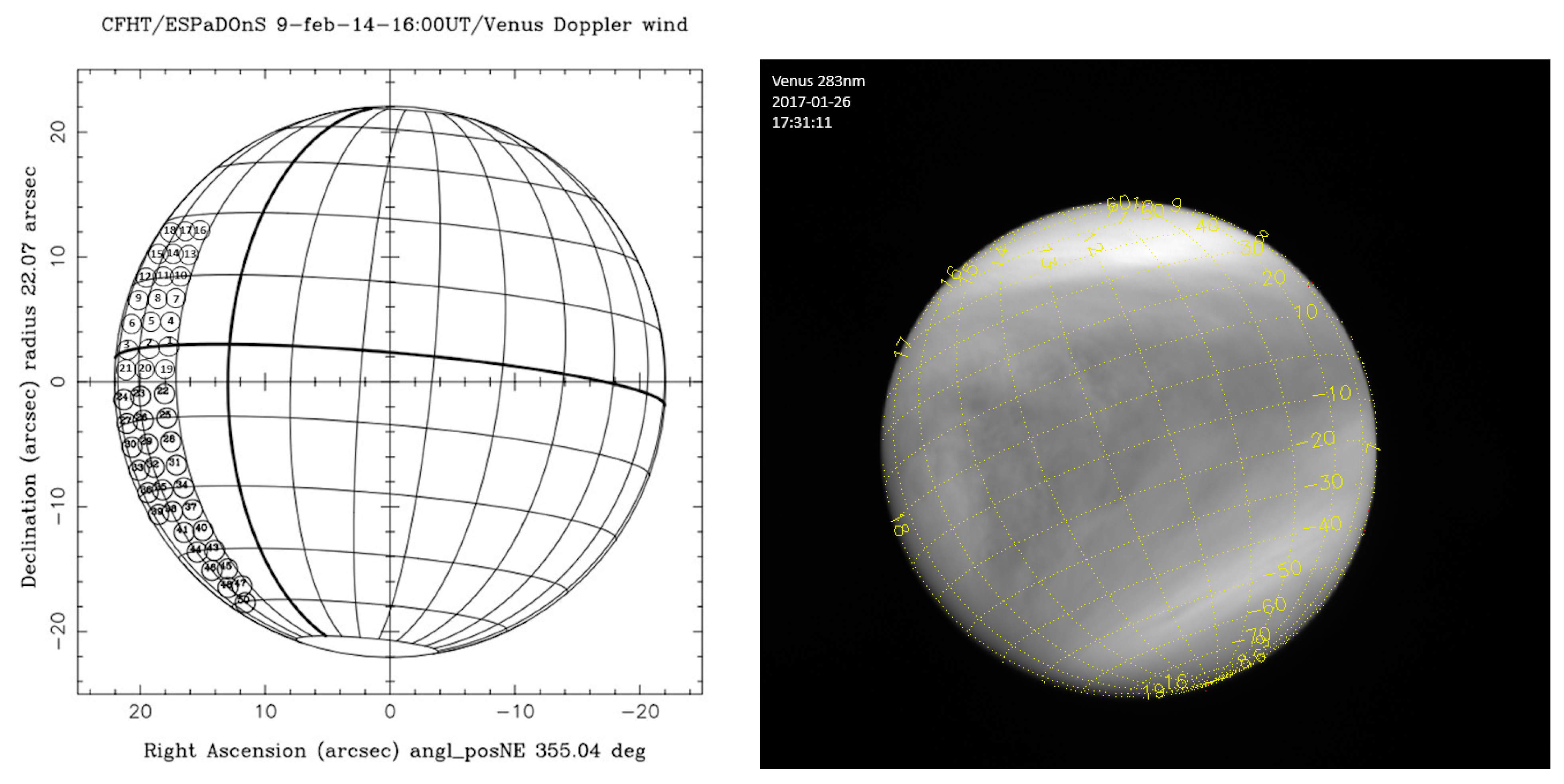
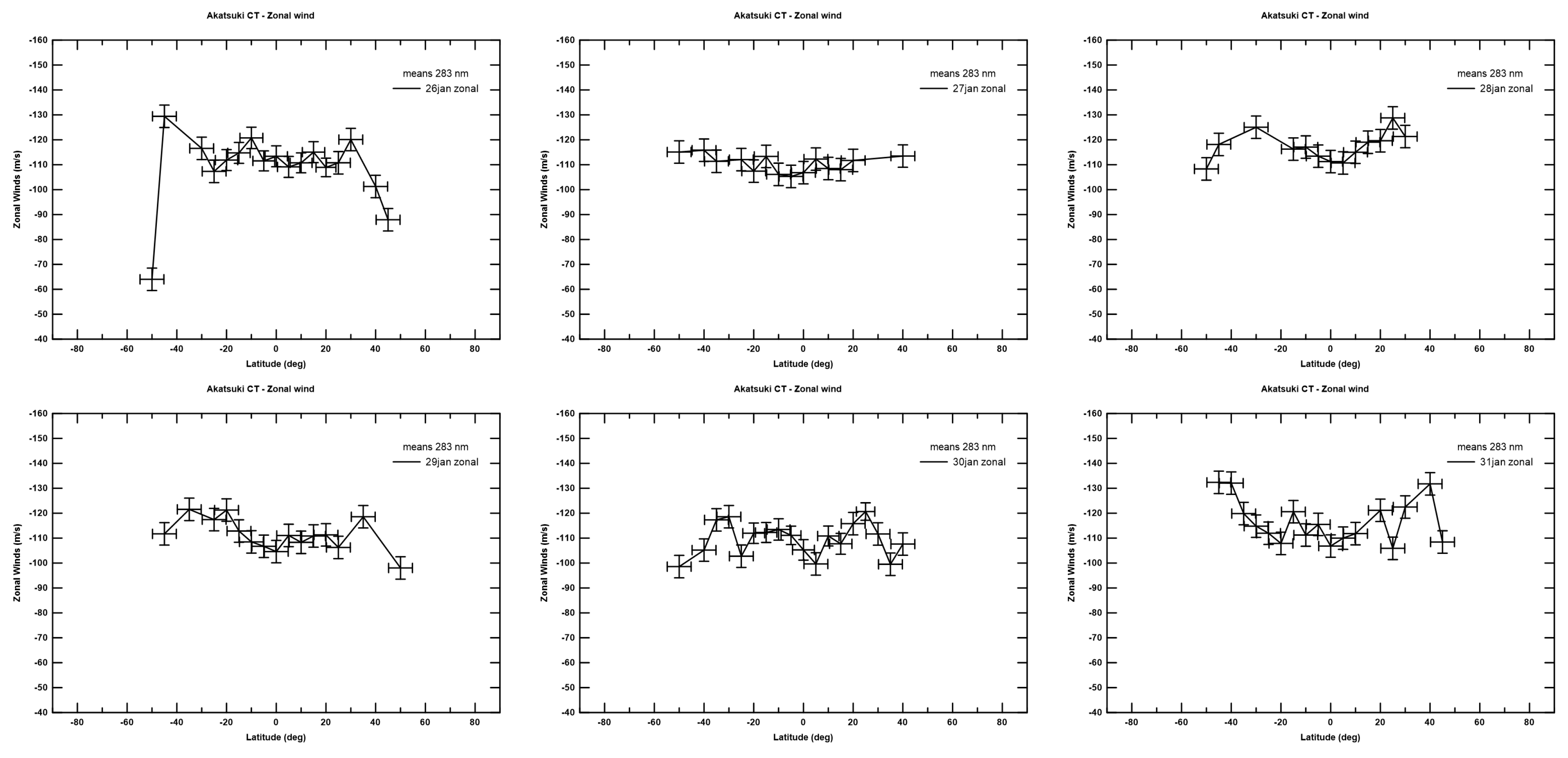
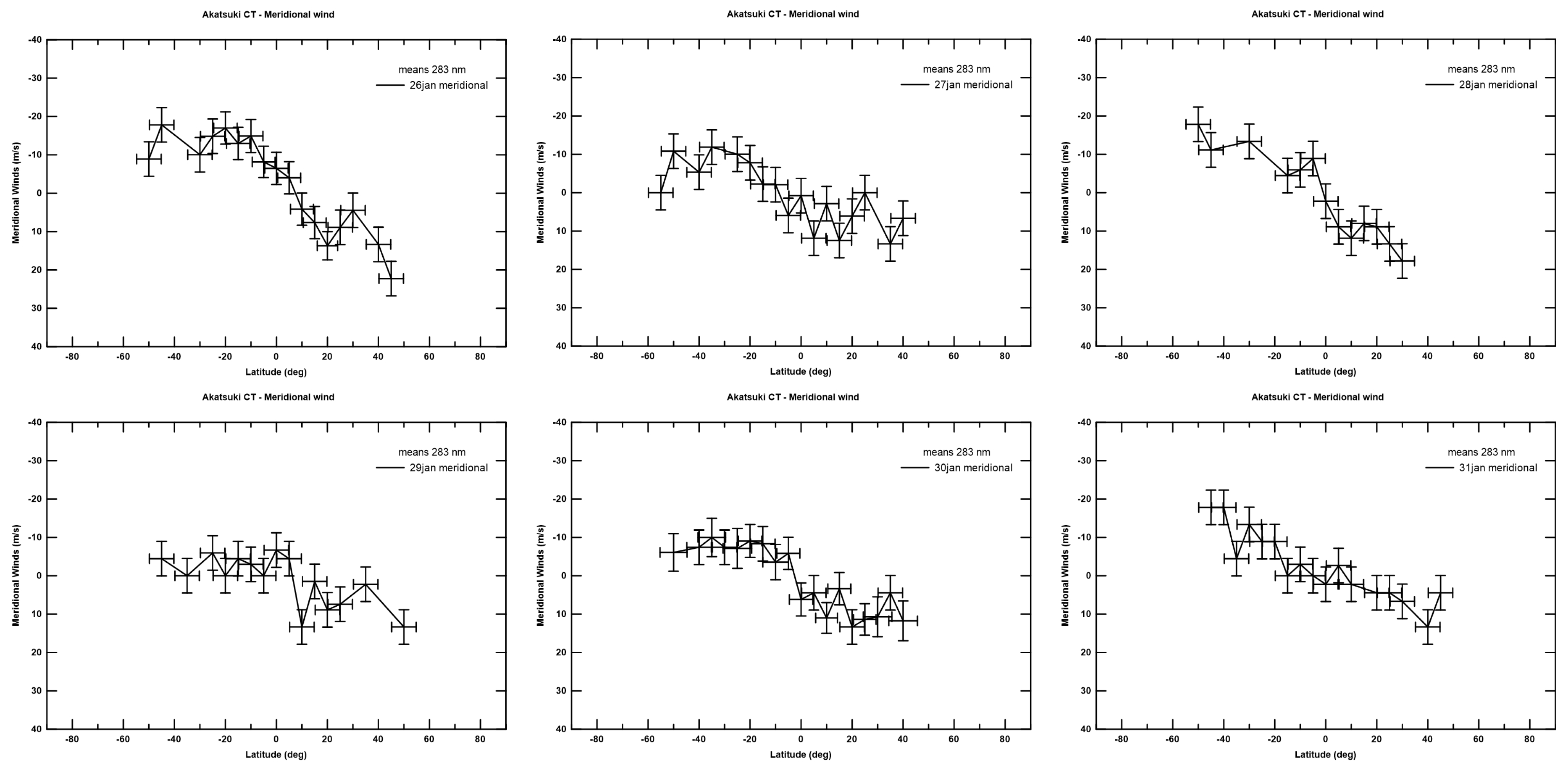
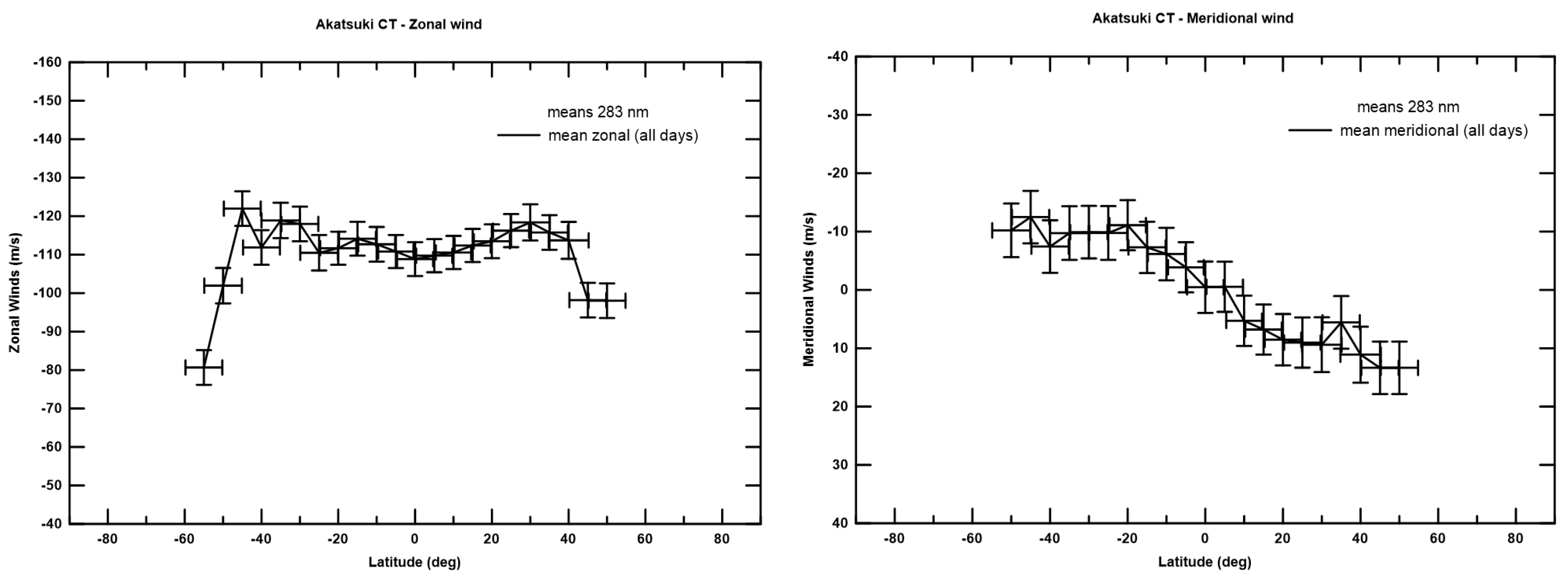
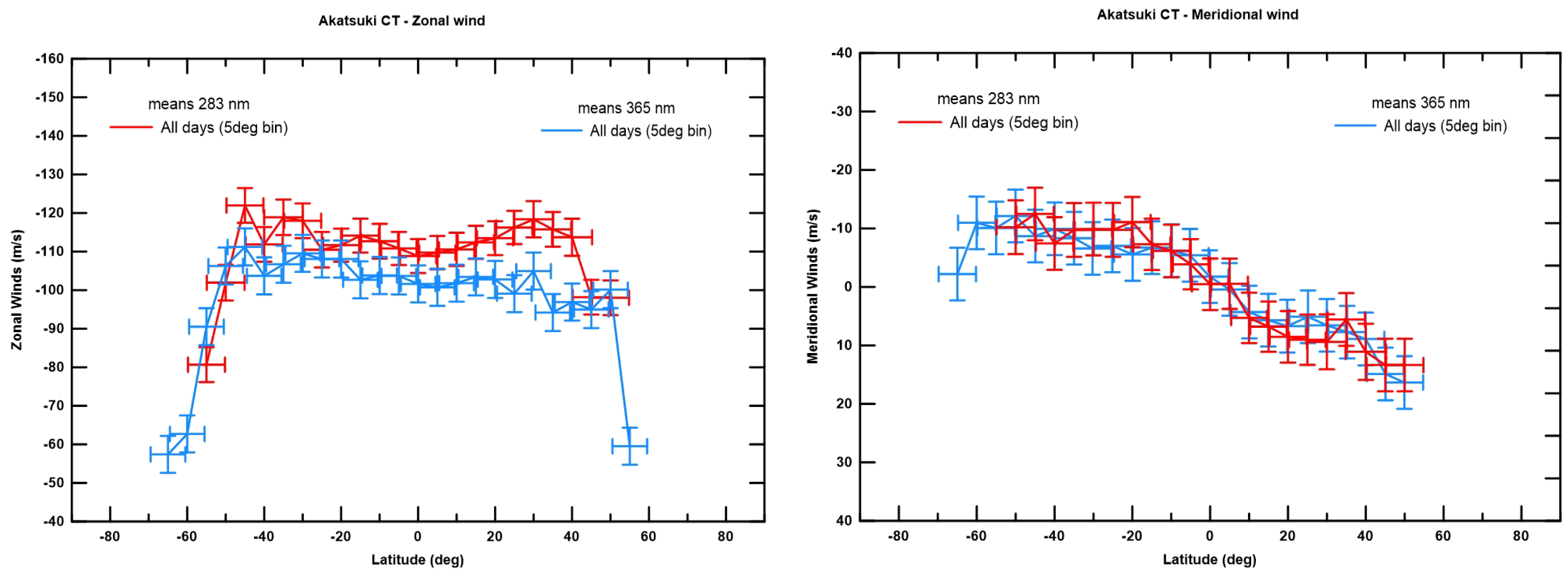
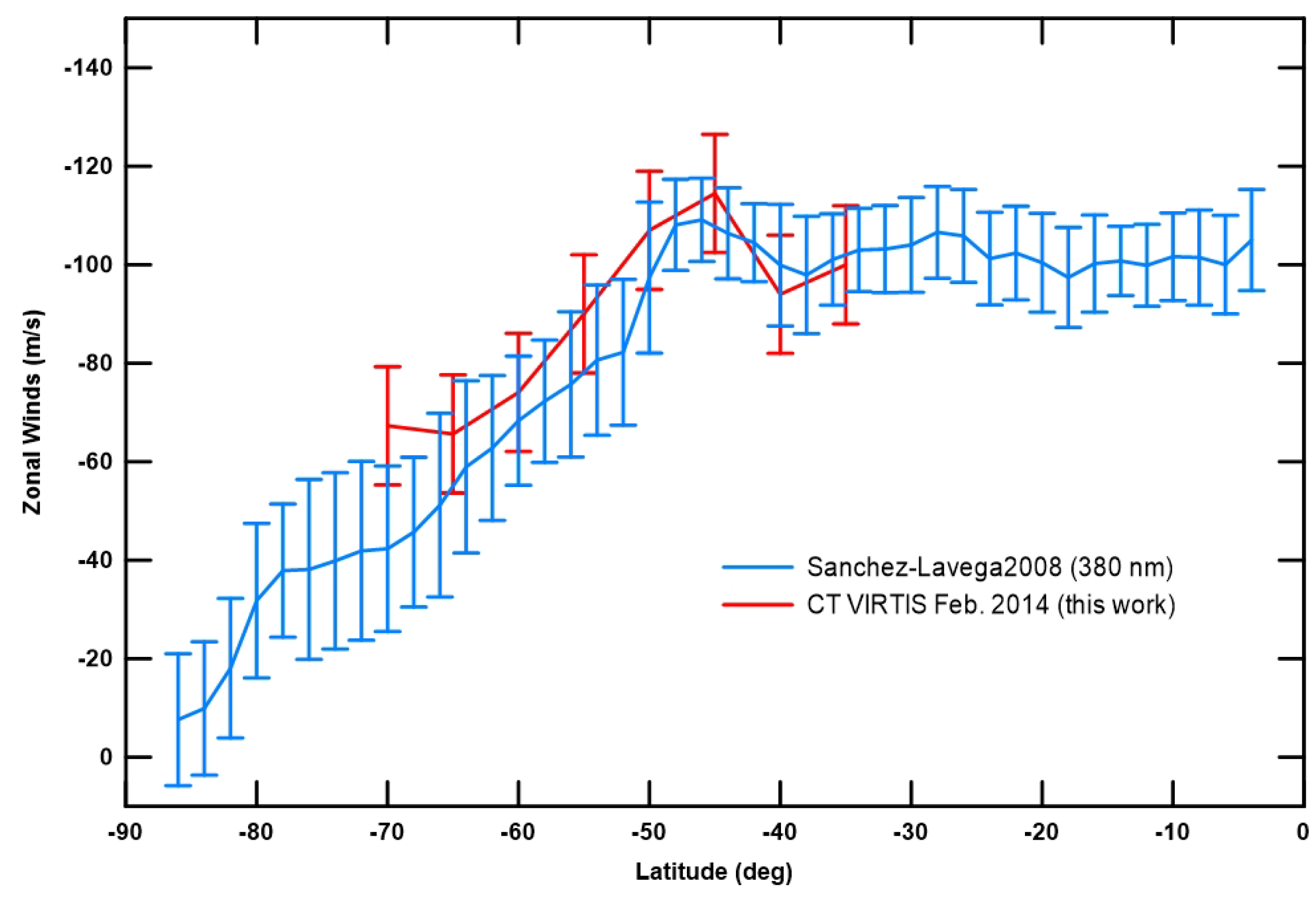
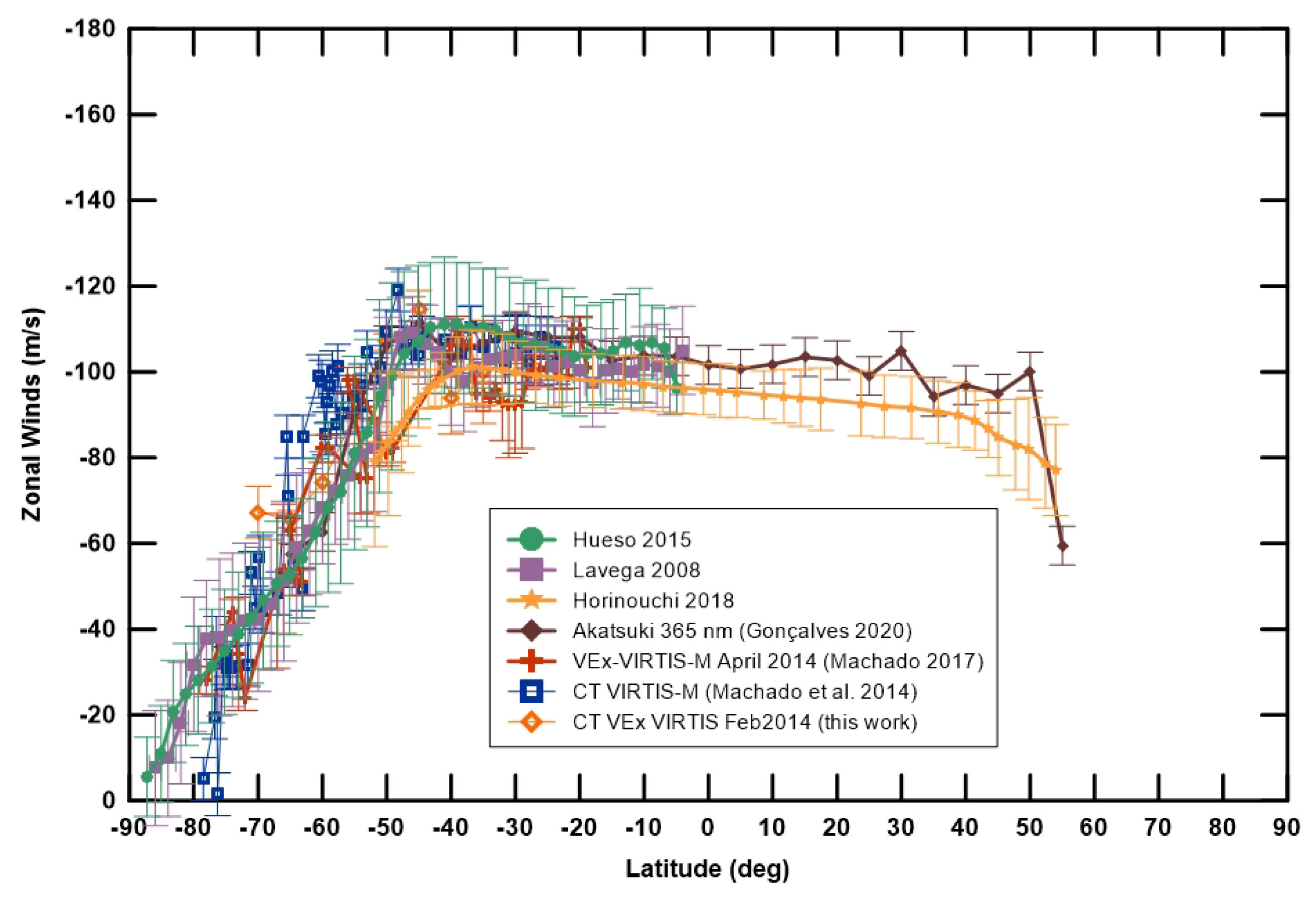
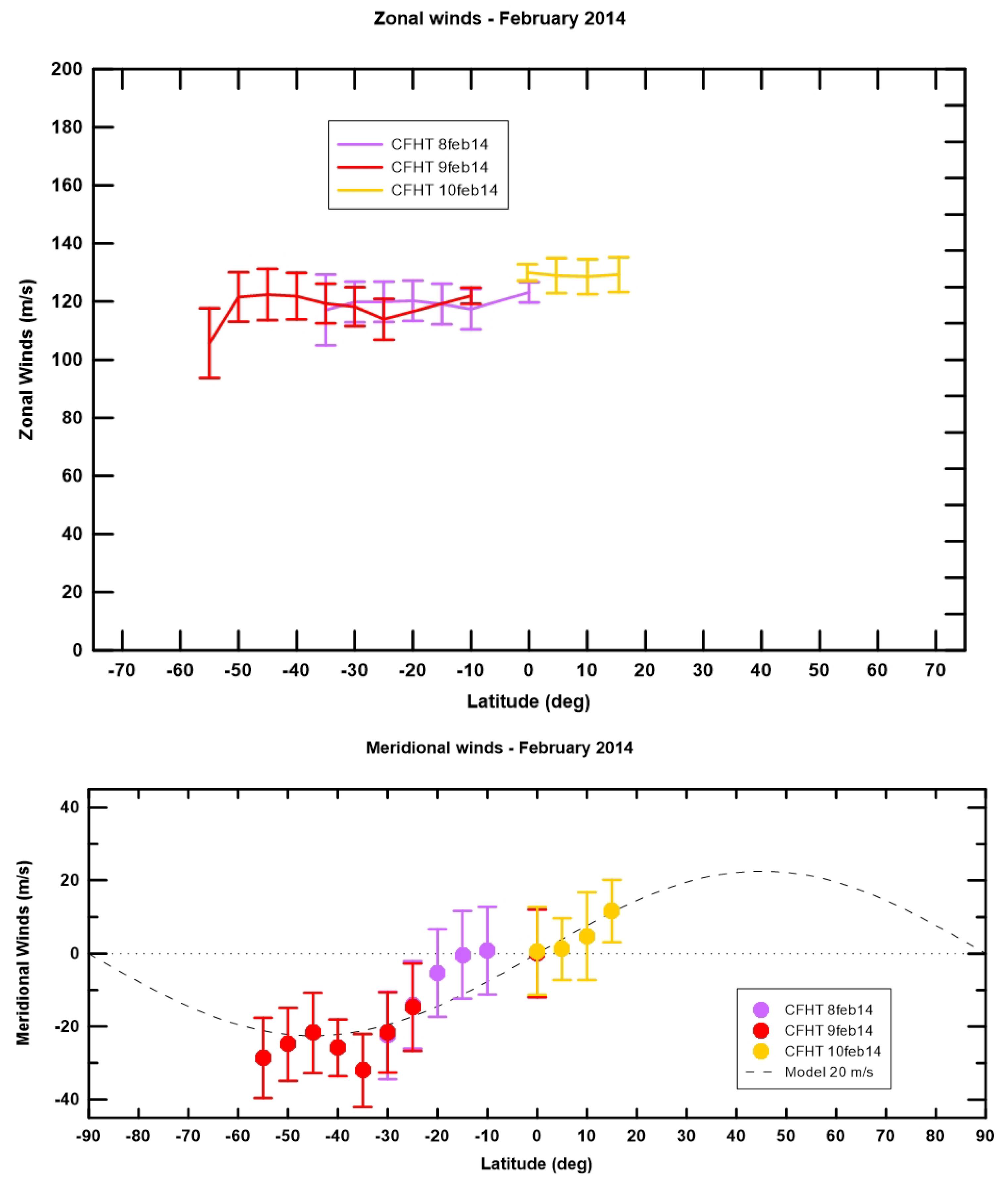

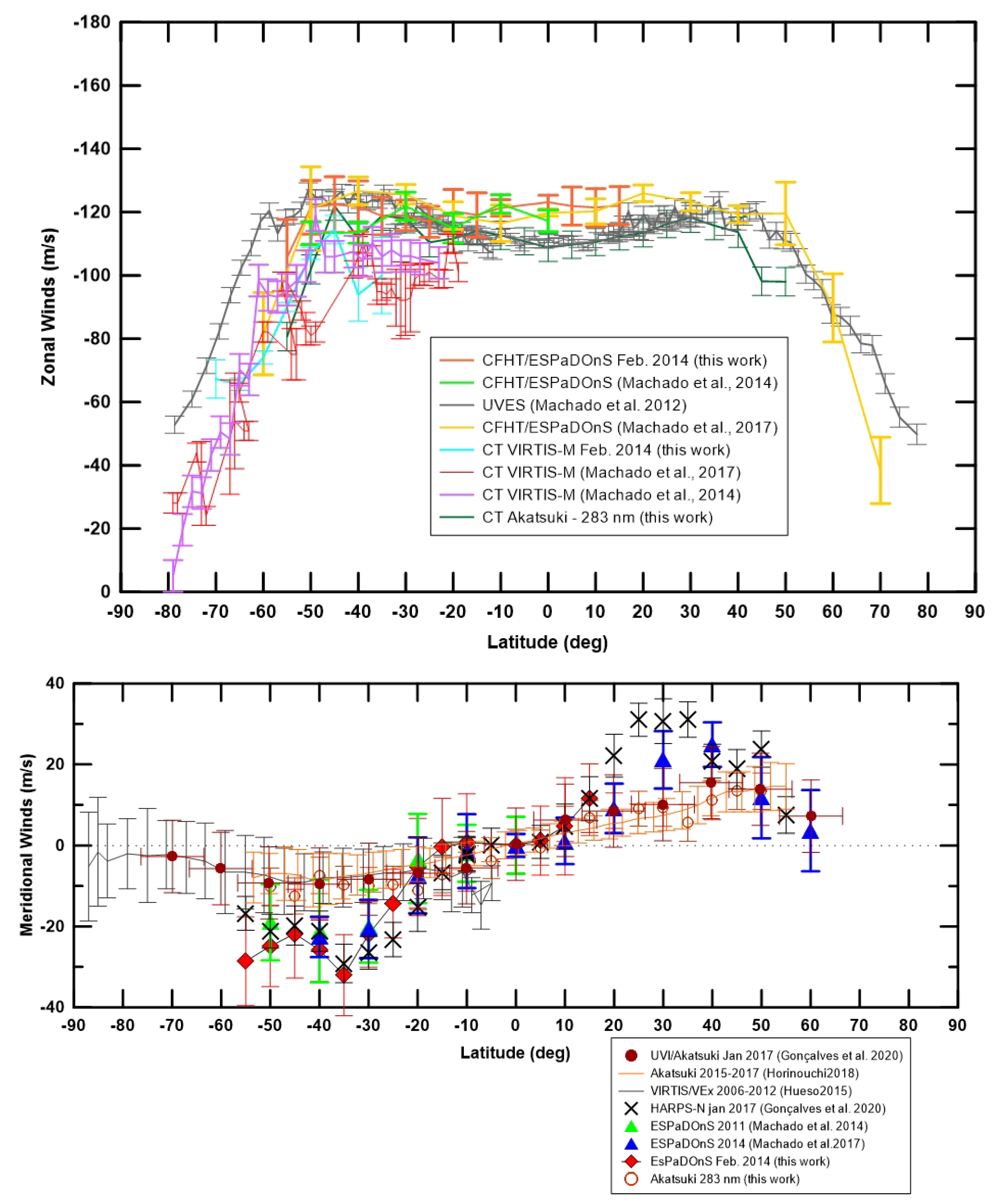
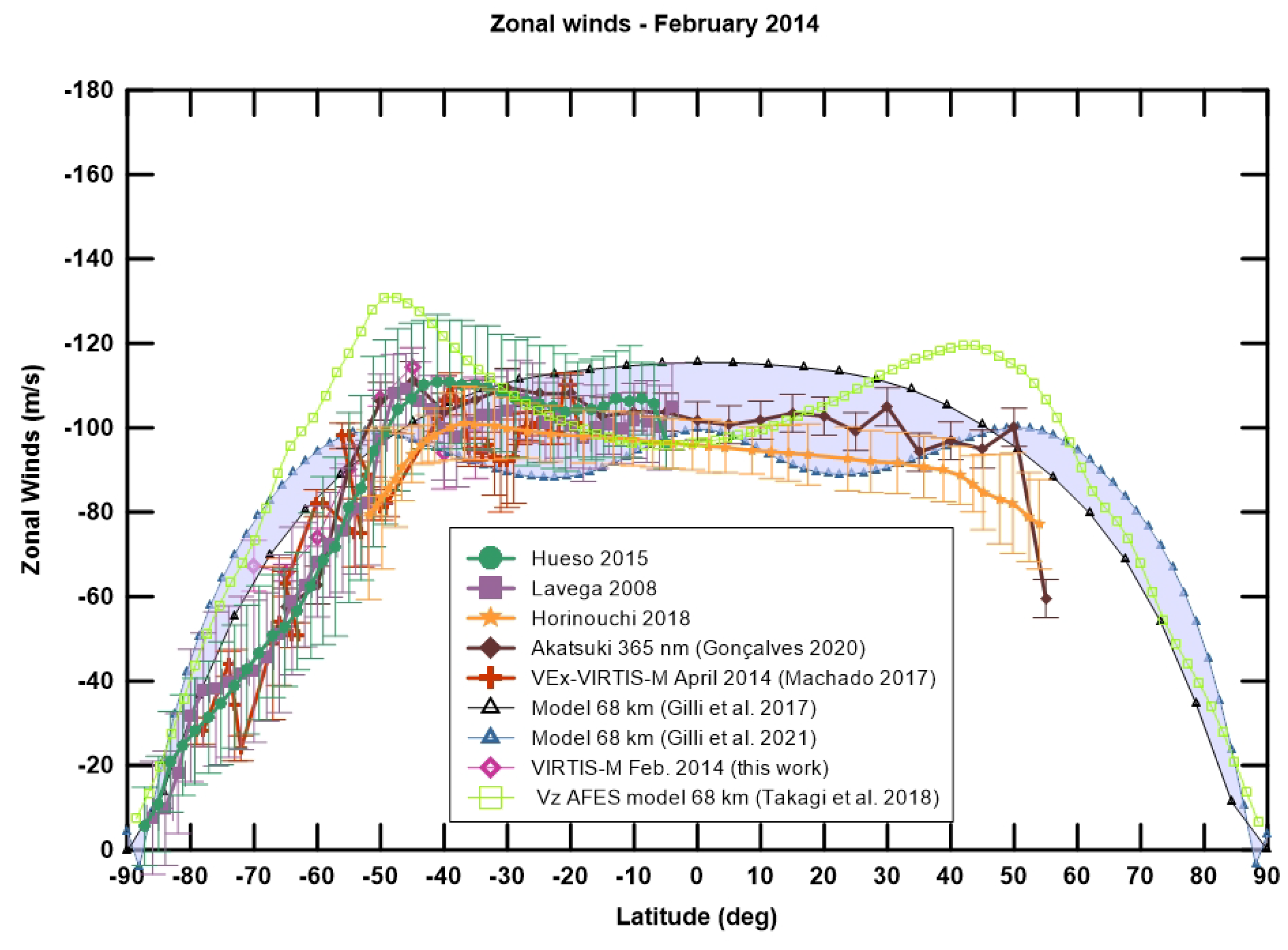
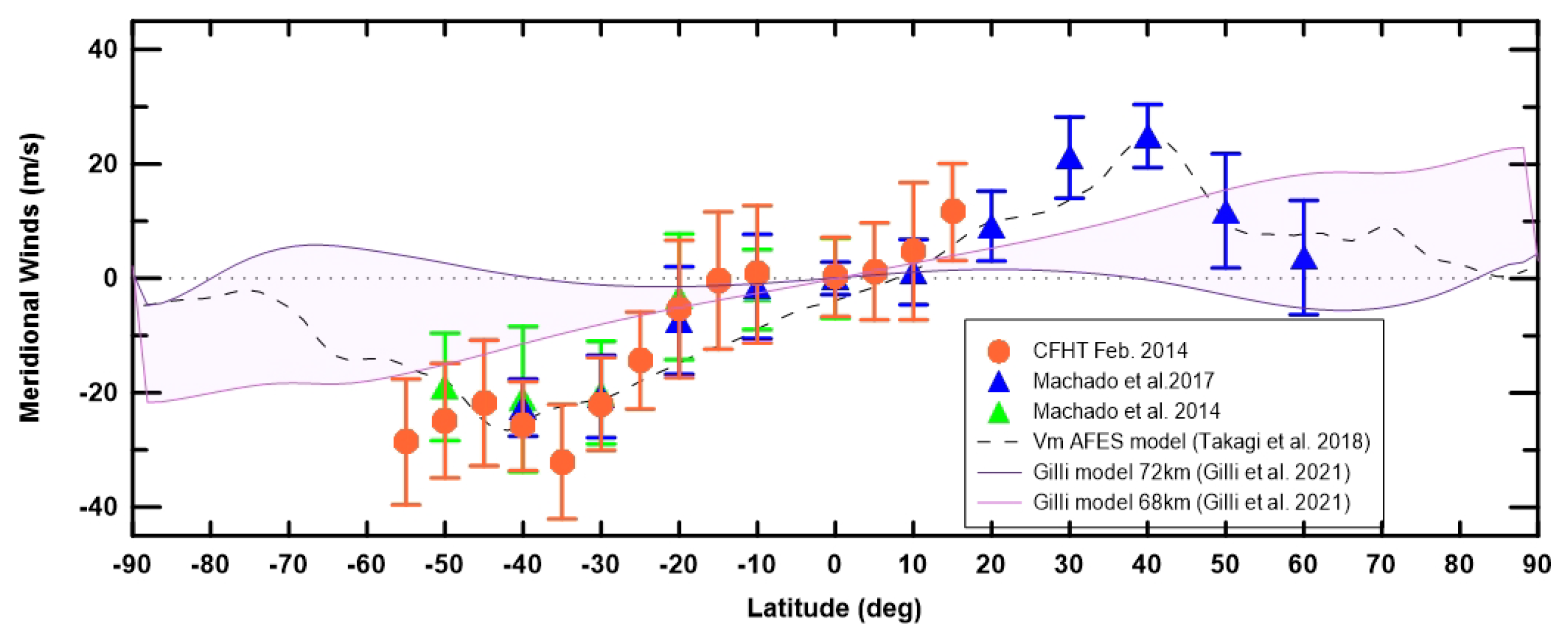
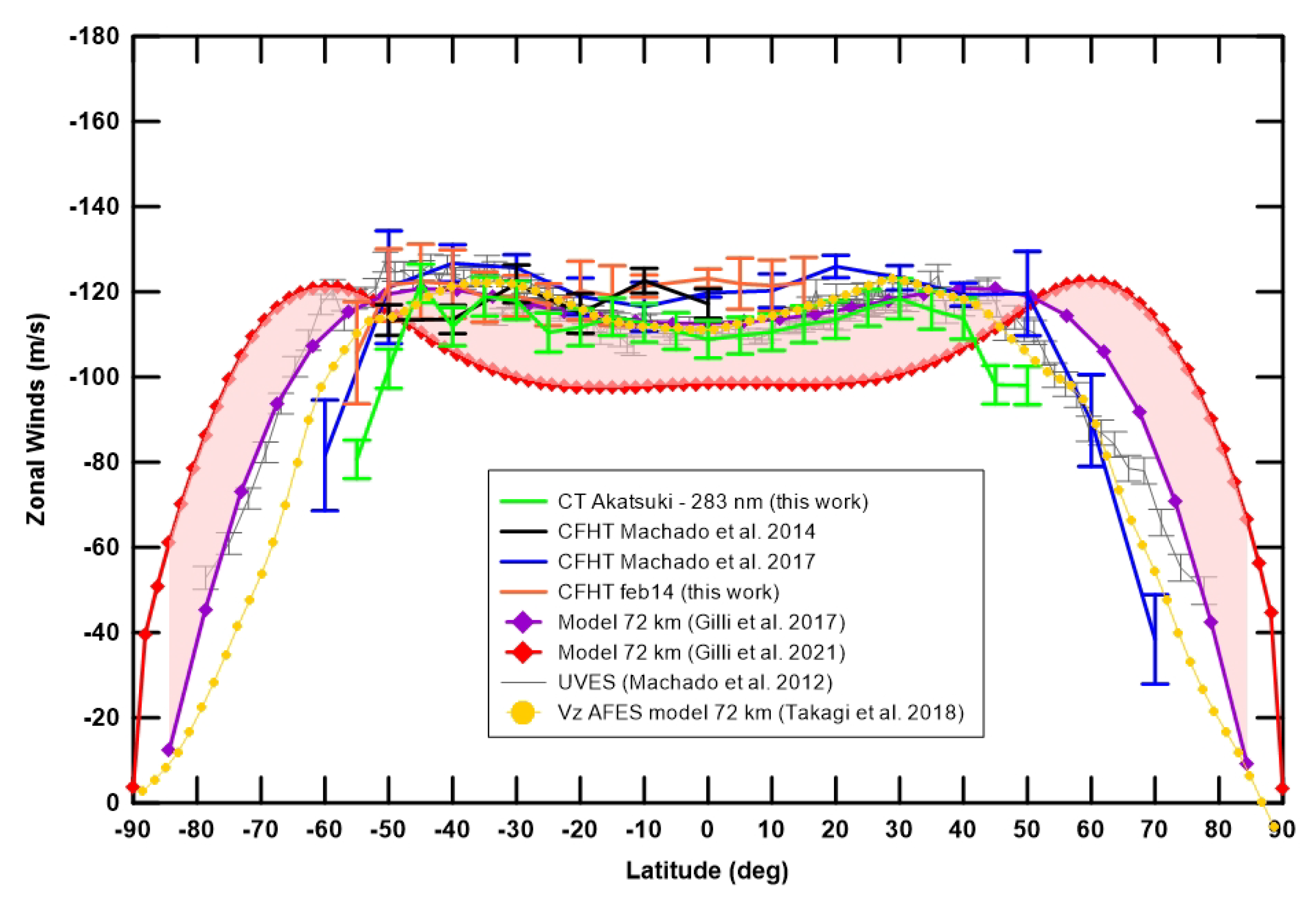
| (1) Date | (2) UT | (3) Phase Angle () | (4) Ill.Fraction (%) | (5) Ang.Diam. (“) | (6)Ob-Lon/Lat () | (7) Airmass | (8) Seeing (“) | (9) PtSize (km) |
|---|---|---|---|---|---|---|---|---|
| 8 February | 15:50–16:43 | 126.96–126.93 | 19.93–19.96 | 45.13–45.11 | 13.92/−6.18 | 3.01–2.16 | 1.1–0.9 | 215 |
| 9 February | 15:58–16:44 | 125.68–125.64 | 20.83–20.86 | 44.39–44.37 | 15.7/−6.1 | 3.08–2.12 | 1.0–0.8 | 218 |
| 10 February | 15.54–16.39 | 124.44–124.39 | 21.73–21.76 | 43.66–43.64 | 17.51/−6.03 | 3.17–2.09 | 0.9–0.8 | 222 |
| (1) VEx Orbit | (2) Qubes Pairs | (3) Date (yyyy/mm/dd) | (4) Time Interval (min) | (5) Latitude Range | (6) Local Time Range | (7) Number of Points |
|---|---|---|---|---|---|---|
| 2851 | VV2851_01 | 2014/02/08 | 48 | 35S–80S | 7 h–16 h | 77 |
| VV2851_04 | ||||||
| 2853 | VV2853_02 | 2014/02/10 | 48 | 5S–70S | 7 h–10 h | 23 |
| VV2853_05 |
| (1) Date and Time UT | (2) deg/px | (3) km/px | (4) Latitude | (5) Local Time | (6) Distance to Venus (km) | (7) Venus’ Diameter (deg) |
|---|---|---|---|---|---|---|
| 26-01-2017 17:31:11 | 0.360 | 38.462 | 72N–88S | 7:30–18:00 | 138,938 | 5.05 |
| 26-01-2017 19:31:11 | 0.391 | 41.772 | 72N–88S | 7:30–18:00 | 150,090 | 4.68 |
| 26-01-2017 21:31:12 | 0.420 | 44.859 | 72N–88S | 7:30–18:00 | 160,630 | 4.37 |
| 27-01-2017 17:01:11 | 0.542 | 57.921 | 75N–85S | 8:00–18:00 | 241,265 | 2.91 |
| 27-01-2017 19:01:11 | 0.556 | 59.377 | 75N–85S | 8:00–18:00 | 247,863 | 2.83 |
| 27-01-2017 21:01:10 | 0.569 | 60.767 | 75N–85S | 8:00–18:00 | 254,218 | 2.76 |
| 28-01-2017 18:01:11 | 0.679 | 72.473 | 75N–85S | 8:30–18:00 | 308,616 | 2.27 |
| 28-01-2017 20:01:11 | 0.686 | 73.349 | 75N–85S | 8:30–18:00 | 312,782 | 2.24 |
| 28-01-2017 22:01:11 | 0.694 | 74.151 | 75N–85S | 8:30–18:00 | 316,792 | 2.21 |
| 29-01-2017 18:51:10 | 0.754 | 80.543 | 75N–85S | 9:00–18:00 | 350,098 | 2.00 |
| 29-01-2017 20:51:10 | 0.758 | 80.983 | 75N–85S | 9:00–18:00 | 352,541 | 1.99 |
| 29-01-2017 22:51:10 | 0.762 | 81.368 | 75N–85S | 9:00–18:00 | 354,861 | 1.98 |
| 30-01-2017 18:01:11 | 0.785 | 83.844 | 75N–85S | 9:15–18:00 | 371,060 | 1.89 |
| 30-01-2017 20:01:10 | 0.785 | 83.862 | 75N–85S | 9:15–18:00 | 372,142 | 1.88 |
| 30-01-2017 22:01:11 | 0.786 | 84.023 | 75N–85S | 9:15–18:00 | 373,111 | 1.88 |
| 31-01-2017 17:21:10 | 0.785 | 84.023 | 70N–80S | 9:50–18:00 | 376,770 | 1.86 |
| 31-01-2017 19:21:09 | 0.784 | 83.817 | 70N–80S | 9:50–18:00 | 376,561 | 1.86 |
| 31-01-2017 21:21:09 | 0.783 | 83.700 | 70N–80S | 9:50–18:00 | 376,241 | 1.86 |
| (1) Sequence number | (2) Location | (3) Time Span (UT) | (4) Points Order | (5) Exposure Repetition |
|---|---|---|---|---|
| 8 February 2014 | ||||
| S lat 10 | 15:50–15:57 | 23-24-23-22-23 | 3× | |
| S lat 15 | 16:01–16:07 | 23-27-26-25-23 | 3× | |
| S lat 10–20 | 16:10–16:21 | 23-30-29-28-24-23 | 3× | |
| S lat 25 | 16:24–16:29 | 23-33-32-31-23 | 3× | |
| S lat 30 | 16:33–16:37 | 23-36-35-34-23 | 3× | |
| S lat 35 | 16:41–16:43 | 23-39-23 | 3× | |
| 9 February 2014 | ||||
| S Lat 25 | 15:58–16:06 | 23-33-32-31-31-23 | 3× | |
| S lat 30 | 16:09–16:14 | 23-36-35-34-23 | 3× | |
| S lat 25–35 | 16:17–16:24 | 23-39-38-37-33-23 | 3× | |
| S lat 40 | 16:30–16:32 | 23-41-40-23 | 3× | |
| S lat 45 | 16:35–16:37 | 23-44-43-23 | 3× | |
| S lat 50 | 16:39–16:41 | 23-46-45-23 | 3× | |
| S lat 25–55 | 16:43–16:44 | 23-48-33-23 | 3× | |
| 10 February 2014 | ||||
| Equator | 15:54–16:05 | 23-3-3-2-1-23 | 3× | |
| N lat 5 | 16:08–16:15 | 23-6-5-5-4-23 | 3× | |
| Equator –N lat 10 | 16:18–16:29 | 23-9-9-8-7-3-23 | 3× | |
| N lat 15 | 16:33–16:39 | 23-12-11-11-10-23 | 3× |
Publisher’s Note: MDPI stays neutral with regard to jurisdictional claims in published maps and institutional affiliations. |
© 2021 by the authors. Licensee MDPI, Basel, Switzerland. This article is an open access article distributed under the terms and conditions of the Creative Commons Attribution (CC BY) license (https://creativecommons.org/licenses/by/4.0/).
Share and Cite
Machado, P.; Widemann, T.; Peralta, J.; Gilli, G.; Espadinha, D.; Silva, J.E.; Brasil, F.; Ribeiro, J.; Gonçalves, R. Venus Atmospheric Dynamics at Two Altitudes: Akatsuki and Venus Express Cloud Tracking, Ground-Based Doppler Observations and Comparison with Modelling. Atmosphere 2021, 12, 506. https://doi.org/10.3390/atmos12040506
Machado P, Widemann T, Peralta J, Gilli G, Espadinha D, Silva JE, Brasil F, Ribeiro J, Gonçalves R. Venus Atmospheric Dynamics at Two Altitudes: Akatsuki and Venus Express Cloud Tracking, Ground-Based Doppler Observations and Comparison with Modelling. Atmosphere. 2021; 12(4):506. https://doi.org/10.3390/atmos12040506
Chicago/Turabian StyleMachado, Pedro, Thomas Widemann, Javier Peralta, Gabriella Gilli, Daniela Espadinha, José E. Silva, Francisco Brasil, José Ribeiro, and Ruben Gonçalves. 2021. "Venus Atmospheric Dynamics at Two Altitudes: Akatsuki and Venus Express Cloud Tracking, Ground-Based Doppler Observations and Comparison with Modelling" Atmosphere 12, no. 4: 506. https://doi.org/10.3390/atmos12040506
APA StyleMachado, P., Widemann, T., Peralta, J., Gilli, G., Espadinha, D., Silva, J. E., Brasil, F., Ribeiro, J., & Gonçalves, R. (2021). Venus Atmospheric Dynamics at Two Altitudes: Akatsuki and Venus Express Cloud Tracking, Ground-Based Doppler Observations and Comparison with Modelling. Atmosphere, 12(4), 506. https://doi.org/10.3390/atmos12040506








